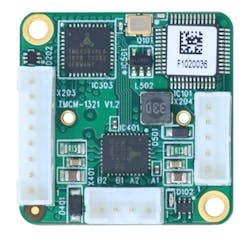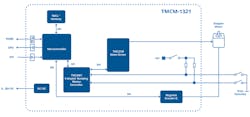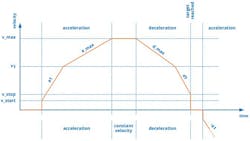Stepper-Motor Servo Controller/Driver Optimizes Speed, Cuts Size and Power
Motor controllers in general and especially closed-loop controllers have come a very long way in the past few years. Control flexibility, adaptability, and strategies that were only dreamed of or very difficult to implement are now embedded in the latest controllers. These new devices now offer increased sophistication, enhanced performance, additional functions and features, and lower power/higher efficiency, while also simplifying use and physical interfacing.
Targeting robotics and automation equipment, the TMCM-1321 servo-controller/driver module from Trinamic Motion Control GmbH & Co. KG (now part of Maxim Integrated Products) extends this trend. It enhances the performance of two-phase bipolar stepper motors by optimizing speed and synchronization of axes in multi-axis applications, and cuts power loss by 75% (Fig. 1). All of this is achieved in a 28- × 28-mm, 20-mm-high package that the vendor maintains is one-third the size of similar stepper-motor control solutions.
Jonas Proeger, Director of Business Management at Trinamic, noted that “when selecting an energy-efficient drive, engineers tend to look at servo drives. However, stepper motors have a considerably higher torque than servo motors of comparable size at low speeds. This makes stepper motors well-suited to get rid of a costly and inefficient gearbox without losing positioning accuracy when you combine them with closed-loop control—you get the efficiency of a servo motor at the cost of a stepper motor.”
The module operates from 9 to 28 V dc and delivers a motor phase current of 0.7 A with up to 128 microsteps per full step. To enable closed-loop operation—an often-desirable trait and increasingly a necessary one—the integral 14-bit magnetic encoder can be used with a magnet attached to the motor axis; alternatively, an optical encoder can be connected via the provided digital inputs (Fig. 2).
In consideration of the targeted applications, the controller includes “Home” and “Stop” switch inputs, also usable as general-purpose inputs. A 115-kb/s RS-485 interface (still widely used) links the TMCM-1321 and system network. Other included features that are needed in such applications include high-precision sensorless load measurement and availability of an automatic current-scaling algorithm to save energy and keep the drive cool.
Ramping profiles are a big part of the story, too. When it comes to efficient control, there’s more to the story than just controlling the motor itself, as the basic controlling strategy must be matched to the motor’s load attributes (such as solid, powder, or liquid). For this reason, the ability to use and tailor complex motor up/down ramping profiles is critical.
In addition to the simple, widely used linear (trapezoidal) ramp and more sophisticated S-shape curve with its gradual change of acceleration (no “jerk”), the TMCM-1321 can implement the company’s SixPoint ramp profile (Fig. 3). This profile adds a user-configurable start/stop frequency to linear motion profiles for faster positioning via the use of additional acceleration segments while reducing the resonances that can occur with basic trapezoidal ramping.
Support collateral includes the datasheet, evaluation kits, and a video explaining the basics of motion control and the evaluation kits. There’s also the Trinamic Motion Control Language - Integrated Development Environment (TMCL-IDE), an integrated development environment made for developing applications using the company’s modules and ICs. This graphical user interface provides tools for easily setting parameters, visualizing data in real-time, and developing and debugging standalone applications with TMCL.
The TMCM-1321 module, priced at $119.40, is available now.



